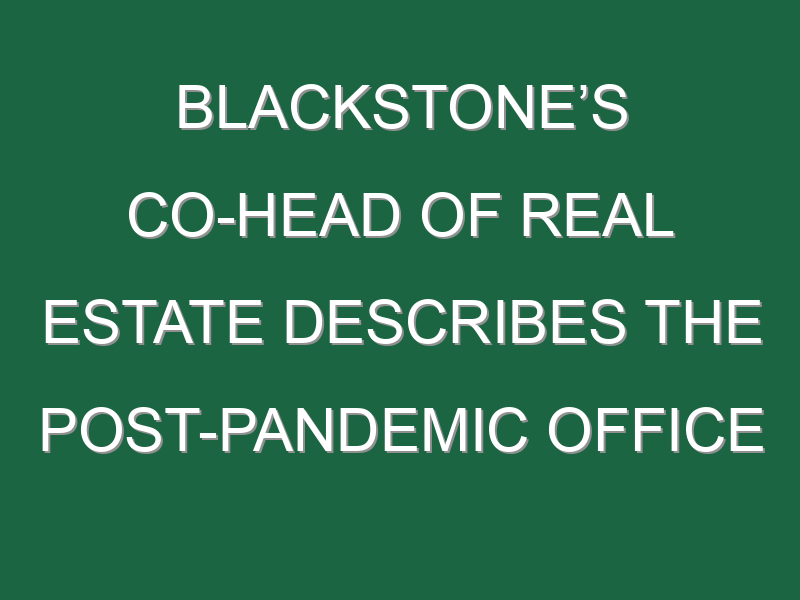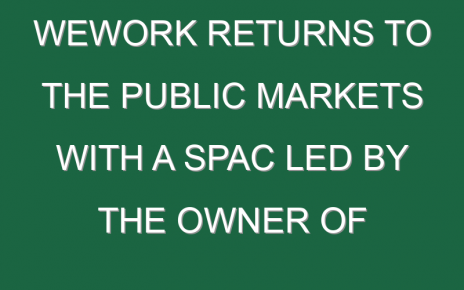Many offices now sit empty as many shops hang by a thread. Casinos, hotels, and amusement parks are fading into memory as consumers turn toward socially distant activities.
So what does the future of real estate—and cities—look like?
That’s the question Fortune posed to Blackstone Global Co-Head of Real Estate Kathleen McCarthy. Even before the pandemic, American malls were on the decline as e-commerce soared, and office spaces were being rejiggering to fit quirky amenities (ahem, beer taps and meditation rooms) common among top companies. The coronavirus, says McCarthy, may well mean that some malls and department stores turn into e-commerce centers, while office spaces undergo more renovation to include, say, better air filtration.
Blackstone, known for its sprawling corporate real estate portfolio, has been remarkably resilient in the pandemic, a phenomenon it attributes to betting early on the rise of the technology and life sciences industries. Blackstone’s biggest real estate bets in recent years have featured warehouses rather than retail spaces: Last year, it acquired Singaporean-based giant GLP for $18.7 billion and U.S.-based Colony Industrial for $5.9 billion. Those all sit within a group of assets it calls logistics, which now make up 36% of its real estate portfolio and is valued at about $90 billion including debt.
Blackstone’s real estate bets are made through two vehicles: Blackstone Real Estate Partners (or BREP) and the Core+ category. While the S&P Global REIT Index, which tracks the performance of property holdings companies, fell about 19% year-to-date as of late October, BREP funds fell just 1.1% year-to-date and the Core+ funds grew 2.2%, the company revealed during its third-quarter earnings call in late October.
Here is our conversation—on why Blackstone decided to invest in warehouses early on and why WeWork wasn’t entirely insane—lightly edited for clarity.
How did Blackstone decide to invest in sectors such as warehouses and life sciences?
We invest by contemplating what is happening in the broader world. When you think about our warehouse investing, life sciences investing, content creation, or rental housing, we look out on the world and say, what are some big mega trends that will or should cause positive tailwinds for real estate? That’s how we’ve ended up with billions in warehouses in the past decade and why we, over the summer, invested in a portfolio of assets in partnership with Hudson Pacific Properties, which are studio assets on the West Coast.
We also examine information coming out of the portfolio both across the firm and across the real estate portfolio. Retail, for example, was a theme we moved away from—I think we haven’t had a traditional mall in the U.S. in 10 years—because we looked out and saw two things happening in the world: Goods were moving online. At the same time we were looking at retail assets we owned a decade ago, and they were doing fine, but we didn’t think they were going to outperform other opportunities for our capital.
Do you have an example of applying information from other parts of Blackstone’s portfolio to make a bet on a real estate asset?
The best example I can think of is actually one in reverse. It’s in biotech: We made an investment in BioMed Realty five years ago in a $8 billion transaction, and recently announced the sale of that company. (Editor’s note: BioMed provides real estate and laboratory space to life sciences companies, and was most recently valued at $14.6 billion, making it the third most profitable transaction by any Blackstone fund.) Our insight into that space led to, in part, the creation of a dedicated life science business in Blackstone, as well as other life science-oriented investments across the firm—our Tactical Opportunities fund later made an investment in Cryoport. (Editor’s note: Blackstone invested $275 million in the company, which helps transport medical goods in controlled temperatures, earlier this year.)
Has Blackstone sought to systematize or quantify the investing process more? For instance, assigning rankings to potential investments based on promise?
We try to find themes we like and dedicate resources and teams in that direction. For example, we have a lot more folks looking for warehouse investments around the world compared to folks tracking what is happening in the retail space. Though we are more cautious on the retail space, we don’t ignore it altogether: We do still need to be aware of what is happening in that sector. We look at all the data available to us coming out of our investments so we are able to react quickly to market information and not wait for external research to tell us what is happening. Increasingly, we are also using data analytics.
So there isn’t a ranking of deals in the pipeline, but generally speaking, we try to focus on finding great opportunities in our highest conviction themes.
Some of those assets in warehousing are probably getting quite expensive now. Where are you looking for opportunity as the pandemic goes on?
COVID has reopened our interest in some sectors while re-emphasizing our caution around retail.
In between those two is our high convictions in global travel and experiential travel. We have a long history of significant investments in hospitality assets, though they are a small portion of our portfolio now, which positioned us well for the coronavirus.
But we continue to believe that people are going to want to get back to traveling and get back together. (Editor’s note: Blackstone has been known in the past for its hotel bets, notably in Hilton Worldwide, which it exited in 2018.)
The other major asset class I haven’t mentioned is offices: Not all office markets are created equal. Certain ones are experiencing a tough moment in COVID. New York City has been one of the ones more impacted—but we are believers in offices, and I think there will continue to be good opportunities, particularly in the markets oriented around innovation, research, and content development.
There are prognostications that cities are dead, and that places like San Francisco and New York are oversaturated.
I don’t know about those specific arguments, but West Coast markets have a lot of drivers and we continue to see strength, particularly in Los Angeles in what is known as the 30-mile zone, where a substantial amount of content is created. I think New York and San Francisco are experiencing a lot of pressure right now, but long-term, we think urban areas will get back to thriving.
So there will be opportunities to invest in distressed assets too.
Yes. We think there will be opportunities to invest.
As the pandemic wears on, though, I’m sure that warehouses, as real estate assets go, are becoming more competitive in terms of dealmaking. Are there certain geographies that are more attractive than others now?
I think our portfolio is gradually getting closer and closer to the most densely populated urban areas. Warehouses, overall, have performed very well, but really the strongest markets are close to the cities where there is the least new supply and the highest demand as sellers need to get goods to their ultimate consumer in the shortest amount of time. The footprint of our portfolio has gotten closer because retailers really need to be able to provide that last-mile part of the chain as consumers want access to goods faster and faster.
As malls and department stores empty out, do you think some of these locations could be repurposed into, say, Amazon fulfillment centers?
I do think we’re going to see some assets that are no longer climbing higher—in retail for instance—converted into other uses, distribution facilities being potentially one of them, or mixed-use community oriented centers being another. I think more generally we’ve seen some of that already happening organically: A great example is Amazon’s purchase of Whole Foods. Amazon used that connection point as a way to get their goods to consumers beyond just what they have in the grocery store. We are seeing the term “buy online and pick up in stores” happening in a number of retail formats where the retailer’s space is driving the flow of e-commerce traffic in addition to store traffic. So some of that will happen organically, and some of them will be more transformational, where someone buys an asset and completely changes its uses.
And what happens to offices?
I think the office was already undergoing an evolution pre-COVID. We saw it in our portfolio and in markets where we operate: Tenants are looking for more than just physical space to get their work done.
Folks want more dynamic lobbies, so office lobbies are turning to look more like hotel lobbies where there are coffee shops, places to sit and chat, and a concierge that isn’t purely security.
And as landlords, we need to ammenitize buildings and also think about the constellation of our tenants so they complement one another. Willis Towers, for example, is one where we have space for tenants to engage with each other, and when you think about the combination of tenants, we have retail and restaurant space that would make it an attractive place to come and work.
And wellness, too: The quality of the air handling and the spaces available for exercise and meditation, all of that was already happening because people were saying, if I have to come into work I want to make sure it’s pleasant. I think COVID, you could argue, is another piece that could accelerate [this trend].
So WeWork wasn’t completely out of its mind?
No. (laughs) I think actually WeWork was really onto something that employers were looking for.




